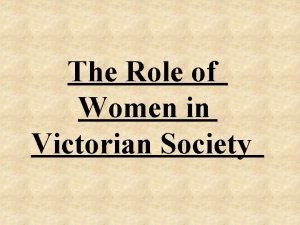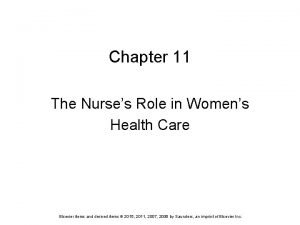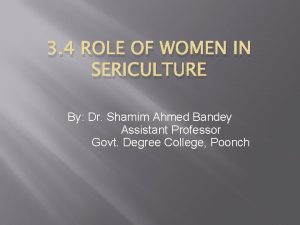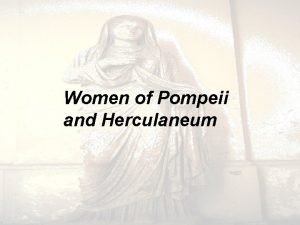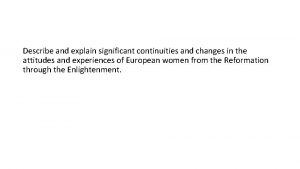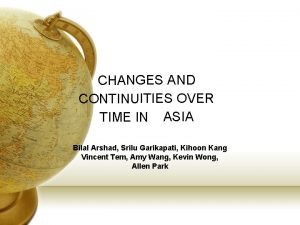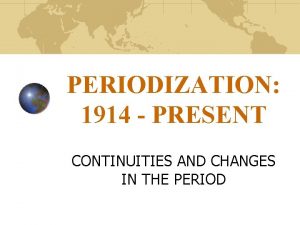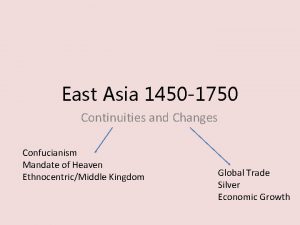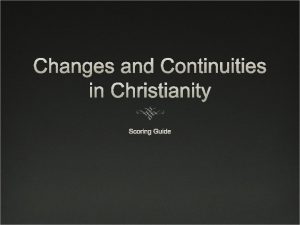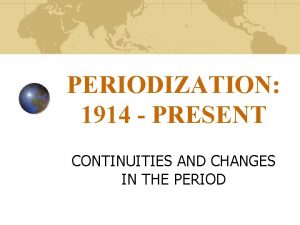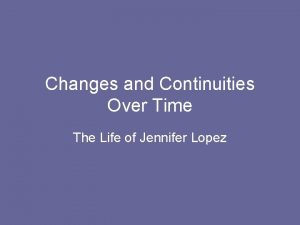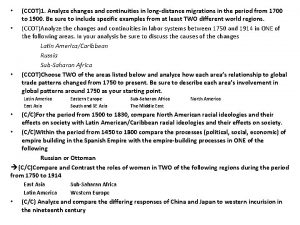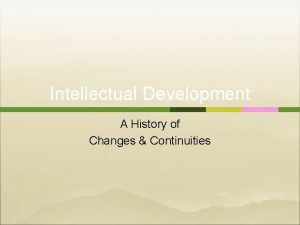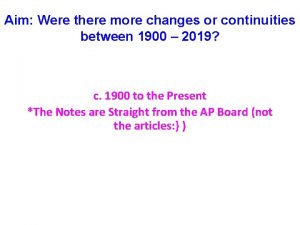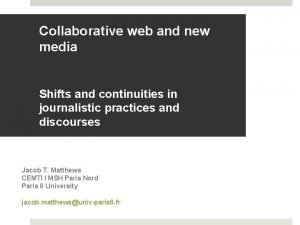Changes and Continuities in the Role of Women




















- Slides: 20

Changes and Continuities in the Role of Women 600 C. E. - 1450 DBQ

What’s Happening? • During this time period, • Islam is spreading • Christianity and Buddhism are opened to new regions • New empires are developed, based on wealth and acquisition of property • Revitalization of neo-Confucianism • These features impacted women’s role in each society.

In general, • Restrictions on women’s freedoms depended on which caste or class they belonged to. • In some regions, women at the highest levels could overcome their status and assume leadership roles if a male heir was not capable. • Generally, however, as societies became more urban and wealthy, women (especially in the elite and upper class) had their freedoms further restricted, even if their status arose. i. e. » Increased veiling in Islamic world » Foot-binding in neo-Confucian China » Young marriage in South Asia

Some Benefits? • Access to more education, especially in China and Japan. • However, overall, women were usually far less powerful than their male counterparts and had many restrictions.

Five Major Regions… • Considering the WHAP exam is going to be asking on a broad spectrum, here are the five major regions one could focus on… Europe Islam Africa India China

Europe • • There were strict patriarchal and social divisions. Women could inherit land. Women could bring a court case but could not participate in the sentence. Women usually worked in textiles; they were divided in labor. Christian Monogamy (1 partner) increased. Education is limited to the upper class males. Veiling of upper class is present.

Islam • There is equality in religion but separate in mosque. • Women received half inheritance of male children. So, if father dies, women receives half of what son would have gotten. • Women’s testimonies had less influence than that of a male. • Concubines and seclusion in harems were present. • Women were exposed to education; literate society. • Veiling is public.


Africa • As trade and new religions increased and arrived, role of women did not change because nomads of African societies were egalitarian. • As sedentary lifestyles developed, societies were matriarchal, where women were dominant in household. – Women demanded a bride-price. – “Mother of the King” was a political office where women held office and participated in religious rituals controlled by women.

India • • There was a strict patriarchal caste system. Women (and men, too!) married at a very young age. Practice of ‘sati’ for widows was present. Marriage is limited to caste members (one cannot marry outside his/her class). • Education is limited. • ‘Purdah’: veiling and seclusion was popular during the time.



China • Confucianism, the dominant religion, held strict guidelines for virtuous behavior. • Women have access to dowries and owned businesses. • Widow must remain with the son and could not own property if they remarried. • The main occupation of women was silk-weaving. • Concubines and seclusion in harems were current during the time. • State education is limited to men; however, women were still literate. • Foot-binding was customary.


This passage from the Qu’ran is considered a primary source and provides a guidelines for husbands to treat their wives. It suggests that men ( being the breadwinners) should use their wealth to support their wive(s). It suggests an obedient woman is virtuous and guides husbands to treat their wives with respect throughout the Islamic world. An additional document from a woman or a case involving a disobedient wife might add further understanding as to the application of the beliefs of husband/wife relations.

This Jewish commentary from the 13 th century suggests that women may join to form a zimun(invitation to say grace) but this is not a general practice in Jewish tradition. It suggests that women do net understand the meaning ( perhaps lacking formalized education through religion or class) and are bestowed the obligation of grace by having scholars say it for them. This suggests, perhaps, that some women may understand but the vast majority do not. A document from a Jewish woman in Europe (where anti-semitism was the norm) who did have grace bestowed upon her due to understanding would give the reader a better understand about how some women could read and attain some scholarly discipline.

This legal code under the Emperor Leo VI of the Byzantine Empire attempts to reverse earlier laws where women were able to serve as witnesses in trials. He sees the appearance of women before large gatherings of men as being dihonorable and suggests that this illustrates a nonvirtuous act on behalf of women ( women in the Byzantine were veiled and secluded although received rights under Justinain’s Code) An additional document from Justinian’s code which allowed women to serve in courts as witnesses would help to understand both the law which facilitated women in court as well as the change in Byzantine society with regard to the role of women ( this is about 350 years after Empress Theodora)

This document from the Song Dynasty suggest that, while women lived under overwhlemingly restrictive households (footbinding), their education was of paramount importance for the duties of maintaining the family financed in the event of a death or just a stupid husband. Yuan Ca offers this advice for family heads which could rarely be the wife except in the case with a deceased husband or young child. The reader(audience of this passage) would probably be an elder male (grandfather) who would encourage knowledge of finances to his daughters/wives/family females. An additional document from the business ledgers of a woman would illustrate how this advice looked in practyical application.

This most famous Muslim Qadis seems impressed by the meticulous nature of prayer ( 5 times a day during specific periods of the day) but is aghast at the intermixing of genders and nudity which was prevalent in many African cultures (but not Northern Africa where Ibn was from). It seems his interpretation on Sharia is different from the customs and traditions in Sub-Saharan/Black Africa. A document from the Sultan’s raection of the Ramandan breaking of fast might provide a beter understanding of why or how the nudity in Islamic Black Africa was percieved perhaps differently from good ole Ibn.

Theses • Women had different treatments in different areas of the post classical period, sometimes positive and sometimes negative treatment. The treatment differed not only for religious reasons, but also in the different societies. However, for some the treatment was not seen as harsh, but actually as a protection to the women, even though the treatment was in reality very negative to many. Other cultures gave women more freedom, rights, and sometimes even respect, a very positive treatment to many. The assortment of documents were from different societies and religious backgrounds, but one can easily say that one point of view in the post classical period towards women was more common than the other. There was little change over time in this negative point of view, it stayed the same for the most part . • In the post classical period, women were treated differently depending on the region in which they lived, the religious views of the region and the way they ran their society. There were parts of the world where they were treated positively and parts where they were treated negatively. A set of five articles were given as examples of the treatment of women throughout time. Each aritcle represented the attitude towards women from different parts of the world. Following are some furthered explanations of the previously explained. • In the post-classical period Religion and Society both developed principles towards the treatment of women. They were different by the region where the texts were written. Religion developed principles in documents 1 and 2 because religion influenced the principle. Society developed principles in documents 3, 4, and 5 because society influenced the principle. In later DBQs there could be the treatment of women in the early and late stages of Europe
 Elizabeth mulroney
Elizabeth mulroney What's a physical change
What's a physical change Role of women in society
Role of women in society Chapter 11 the nurse's role in women's healthcare
Chapter 11 the nurse's role in women's healthcare Role of women in sericulture
Role of women in sericulture Herculaneum women
Herculaneum women Rachel kimery
Rachel kimery Azure worker role
Azure worker role Lothar krappmann
Lothar krappmann Statuses and their related roles determine the structure
Statuses and their related roles determine the structure Hát kết hợp bộ gõ cơ thể
Hát kết hợp bộ gõ cơ thể Lp html
Lp html Bổ thể
Bổ thể Tỉ lệ cơ thể trẻ em
Tỉ lệ cơ thể trẻ em Chó sói
Chó sói Chụp tư thế worms-breton
Chụp tư thế worms-breton Chúa sống lại
Chúa sống lại Các môn thể thao bắt đầu bằng từ đua
Các môn thể thao bắt đầu bằng từ đua Thế nào là hệ số cao nhất
Thế nào là hệ số cao nhất Các châu lục và đại dương trên thế giới
Các châu lục và đại dương trên thế giới Công của trọng lực
Công của trọng lực


